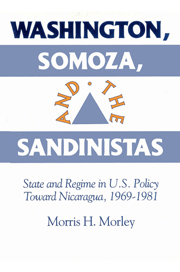Book contents
- Frontmatter
- Contents
- Acknowledgments
- 1 Introduction: Permanent and transitory interests in U.S. foreign policy
- 2 Washington and the Somoza dynasty: From consolidation to crisis of a client dictatorship
- 3 Supporting Somoza: Substance and symbol in American policy during the Nixon-Ford era
- 4 The Carter administration and Nicaragua: Human rights and the politics of accommodation
- 5 The Carter administration and Nicaragua: Mediation and the politics of frustration
- 6 Washington ruptures a historic relationship: Dumping the dictator to save the state
- 7 The Carter administration and revolutionary Nicaragua: Containing Sandinista power
- 8 Conclusion
- Bibliography
- Index
6 - Washington ruptures a historic relationship: Dumping the dictator to save the state
Published online by Cambridge University Press: 31 March 2010
- Frontmatter
- Contents
- Acknowledgments
- 1 Introduction: Permanent and transitory interests in U.S. foreign policy
- 2 Washington and the Somoza dynasty: From consolidation to crisis of a client dictatorship
- 3 Supporting Somoza: Substance and symbol in American policy during the Nixon-Ford era
- 4 The Carter administration and Nicaragua: Human rights and the politics of accommodation
- 5 The Carter administration and Nicaragua: Mediation and the politics of frustration
- 6 Washington ruptures a historic relationship: Dumping the dictator to save the state
- 7 The Carter administration and revolutionary Nicaragua: Containing Sandinista power
- 8 Conclusion
- Bibliography
- Index
Summary
In May 1979, after more than four decades of support for the Somoza family dynasty in Nicaragua, the threat to the state posed by a popular revolutionary movement led by Sandinista guerrillas forced Washington to adopt a position in favor of supporting a regime change. This policy shift was inextricably linked to dramatic changes in the nature of the socio-political and military struggles.
After the September 1978 insurrectionary upheaval, the FSLN embarked on a concerted effort to broaden its political base, supporting the establishment of the United People's Movement (MPU) and, subsequently, the National Patriotic Front (FPN). The emergence of structured urban support networks, including armed militias, civil defense units, and neighborhood committees, complemented these moves. The Sandinistas further consolidated their hegemonic status among the anti-regime forces when the three “tendencies” (Proletarian, Prolonged People's War, and Insurrectional/ Tercerista) resolved their tactical and strategic differences, and established a unified high command. Within the space of nine months, the FSLN was transformed from an organization numbering approximately 600 active members1 to unchallenged head of a mass social movement of wage workers, urban poor, peasants, students, property owners, and churchpeople, and their respective political, labor, and civic organizations. This severely complicated Washington's ability to gain control of events and shape their outcome in a manner compatible with U.S. permanent interests.
Between January and April 1979, the military conflict escalated from relatively small-scale, rurally based confrontations to major clashes in cities and towns. On March 8, for instance, American Embassy Chargé d’ Affaires Frank Tucker reported that “fighting between the Guardia and increasingly large groups of Sandinistas is intensifying in the northern mountains and in areas in the South, some within 20-30 miles of Managua.”
- Type
- Chapter
- Information
- Washington, Somoza and the SandinistasStage and Regime in US Policy toward Nicaragua 1969–1981, pp. 172 - 217Publisher: Cambridge University PressPrint publication year: 1994



